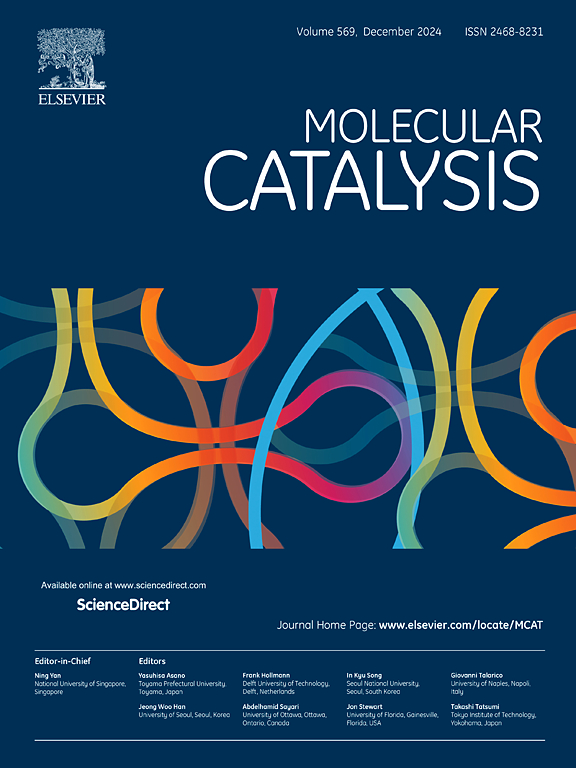通过La³+掺杂MoO3-x /碳点s型光催化剂实现高环己酮选择性
IF 4.9
2区 化学
Q2 CHEMISTRY, PHYSICAL
引用次数: 0
摘要
克服环己醇到环己酮转化过程中高能耗和过氧化的限制需要高效的光催化策略。这项工作提出了一种双工程MoO3-x催化剂,通过La³+掺杂修饰,并与富电子碳点(CDs)偶联,形成s型异质结(lmocd)。La³⁺掺杂导致晶格畸变和氧空位,增强载流子迁移率,而与CDs的S-scheme结显著促进了电荷分离,实现了定向界面电子转移。在环境条件下,优化后的LMOCDs催化剂实现了97.7%的环己酮选择性和19.1%的转化效率,比原始MoO3-x提高了1.93倍。La³+掺杂和CDs复合的协同作用不仅促进了环己醇的选择性吸附,而且显著提高了光生载流子的利用率。光电化学表征、能带对准分析和自由基捕获实验阐明了其潜在的机制。该研究证明了组合阳离子掺杂和s -图式异质结工程在开发高性能选择性氧化光催化体系中的关键作用。本文章由计算机程序翻译,如有差异,请以英文原文为准。

Achieving high cyclohexanone selectivity via La³⁺-Doped MoO3-x /Carbon dot s-scheme photocatalyst
Overcoming the limitations of high energy consumption and over-oxidation in cyclohexanol-to-cyclohexanone conversion requires efficient photocatalytic strategies. This work presents a dual-engineered MoO3-x catalyst, modified through La³⁺ doping and coupled with electron-enriched carbon dots (CDs) to form an S-scheme heterojunction (LMO![]() CDs). La³⁺ doping induces lattice distortion and oxygen vacancies, enhancing carrier mobility, while the S-scheme junction with CDs significantly boosts charge separation and enables directional interfacial electron transfer. Under ambient conditions, the optimized LMO
CDs). La³⁺ doping induces lattice distortion and oxygen vacancies, enhancing carrier mobility, while the S-scheme junction with CDs significantly boosts charge separation and enables directional interfacial electron transfer. Under ambient conditions, the optimized LMO![]() CDs catalyst achieves exceptional cyclohexanone selectivity of 97.7 % and a conversion efficiency of 19.1 %, representing a 1.93-fold enhancement over pristine MoO3-x. The synergistic effects of La³⁺ doping and CDs compounding not only promote the selective adsorption of cyclohexanol but also dramatically improve the utilization of photogenerated charge carriers. Photoelectrochemical characterization, band alignment analysis, and radical trapping experiments elucidate the underlying mechanism. This study demonstrates the pivotal role of combined cation doping and S-scheme heterojunction engineering in developing high-performance photocatalytic systems for selective oxidation.
CDs catalyst achieves exceptional cyclohexanone selectivity of 97.7 % and a conversion efficiency of 19.1 %, representing a 1.93-fold enhancement over pristine MoO3-x. The synergistic effects of La³⁺ doping and CDs compounding not only promote the selective adsorption of cyclohexanol but also dramatically improve the utilization of photogenerated charge carriers. Photoelectrochemical characterization, band alignment analysis, and radical trapping experiments elucidate the underlying mechanism. This study demonstrates the pivotal role of combined cation doping and S-scheme heterojunction engineering in developing high-performance photocatalytic systems for selective oxidation.
求助全文
通过发布文献求助,成功后即可免费获取论文全文。
去求助
来源期刊

Molecular Catalysis
Chemical Engineering-Process Chemistry and Technology
CiteScore
6.90
自引率
10.90%
发文量
700
审稿时长
40 days
期刊介绍:
Molecular Catalysis publishes full papers that are original, rigorous, and scholarly contributions examining the molecular and atomic aspects of catalytic activation and reaction mechanisms. The fields covered are:
Heterogeneous catalysis including immobilized molecular catalysts
Homogeneous catalysis including organocatalysis, organometallic catalysis and biocatalysis
Photo- and electrochemistry
Theoretical aspects of catalysis analyzed by computational methods
 求助内容:
求助内容: 应助结果提醒方式:
应助结果提醒方式:


